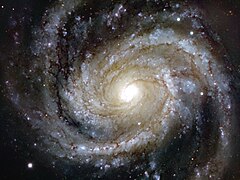Messier 100
 Zdjęcie z VLT (ESO) | |
| Odkrywca | |
|---|---|
| Data odkrycia | 15 marca 1781 |
| Dane obserwacyjne (J2000) | |
| Gwiazdozbiór | |
| Typ | Sc |
| Rektascensja | 12h 22m 54,84s |
| Deklinacja | +15° 49′ 19,5″ |
| Odległość | |
| Przesunięcie ku czerwieni | 0,005250[1] |
| Jasność obserwowana | 9,4m |
| Rozmiary kątowe | 7' × 6' |
| Charakterystyka fizyczna | |
| Wymiary | 120 tys. ly |
| Alternatywne oznaczenia | |
| M100, NGC 4321, PGC 40153, UGC 7450, MCG +03-32-015 | |
 Położenie M100 na niebie | |
Messier 100 (również M100, NGC 4321 lub PGC 40153) – galaktyka spiralna znajdująca się w gwiazdozbiorze Warkocza Bereniki. Odkrył ją 15 marca 1781 roku Pierre Méchain[2]. W katalogu Messiera od 13 kwietnia 1781 roku[2].
M100 jest jednym z najjaśniejszych obiektów w gromadzie w Pannie.
M100 znajduje się w odległości ok. 56 milionów lat świetlnych od Ziemi. Średnica galaktyki wynosi ok. 120 tysięcy lat świetlnych.
Supernowe
Do tej pory w M100 zaobserwowano pięć supernowych[3]:
- SN 1901B (w marcu 1901 – jasność 15,6m, typ I)
- SN 1914A (w lutym/marcu 1914 – jasność 15,7m)
- SN 1959E (w sierpniu/wrześniu 1959 – jasność 17,5m, typ I)
- SN 1979C (15 kwietnia 1979 – jasność 11,6m, typ II)
- SN 2006X (7 lutego 2006 – jasność 15,3m, typ Ia)

Zobacz też
Przypisy
- ↑ Messier 100 w bazie SIMBAD (ang.)
- ↑ a b Courtney Seligman: NGC 4321 (ang.). W: Celestial Atlas [on-line]. [dostęp 2014-11-23].
- ↑ List of Supernovae (ang.). W: IAU Central Bureau for Astronomical Telegrams [on-line]. Międzynarodowa Unia Astronomiczna. [dostęp 2014-11-23].
Linki zewnętrzne
- Messier 100 w NASA/IPAC Extragalactic Database (ang.)
- Messier 100 w SEDS.org (ang.)
- Messier 100 w bazie SIMBAD (ang.)
Media użyte na tej stronie
Autor: Original uploader was Blueshade at pl.wikipedia, Licencja: CC-BY-SA-3.0
Ta mapa gwiazdozbioru została stworzona przy pomocy programu PP3 autorstwa Torstena Brongera. Tłumaczenia na język polski oraz innych modyfikacji na potrzeby polskiej Wikipedii dokonał Przemysław 'BlueShade' Idzkiewicz. Grafika udostępniona jest na licencji GFDL w wersji 1.2 lub nowszej.
Autor: ESO, Licencja: CC BY 4.0
Spiral galaxies are usually very aesthetically appealing objects, and never more so than when they appear face-on. And this image is a particularly splendid example: it is the grand design spiral galaxy Messier 100, located in the southern part of the constellation of Coma Berenices, and lying about 55 million light-years from Earth.
While Messier 100 shows very well defined spiral arms, it also displays the faintest of bar-like structures in the centre, which classifies this as type SAB. Although it is not easily spotted in the image, scientists have been able to confirm the bar’s existence by observing it in other wavelengths.
This very detailed image shows the main features expected in a galaxy of this type: huge clouds of hydrogen gas, glowing in red patches when they re-emit the energy absorbed from newly born, massive stars; the uniform brightness of older, yellowish stars near the centre; and black shreds of dust weaving through the arms of the galaxy.
Messier 100 is one of the brightest members of the Virgo Cluster, which is the closest cluster of galaxies to our galaxy, the Milky Way, containing over 2000 galaxies, including spirals, ellipticals, and irregulars. This picture is a combination of images from the FORS instrument on ESO’s Very Large Telescope at Paranal Observatory in Chile, taken with red (R), green (V) and blue (B) filters.Autor: ESO/P. Grosbøl, Licencja: CC BY 4.0
This galaxy is Messier 100, also known as NGC 4321, which was discovered in the 18th century. About 55 million light-years from Earth, Messier 100 is part of the Virgo Cluster of galaxies and lies in the constellation of Coma Berenices (Berenice’s Hair, named after the ancient Egyptian queen Berenice II). The image was made in infrared light with the HAWK-I camera on ESO’s Very Large Telescope at Paranal Observatory in Chile. HAWK-I is one of the most powerful infrared imagers in the world, and this is one of the sharpest and most detailed pictures of this galaxy ever taken from Earth. The filters used were Y (shown here in blue), J (in cyan), H (in orange), and K (in red). The field of view of the image is about 6.4 arcminutes.
Zdjęcie wykonane w ramach projektu Faukles Telescope




